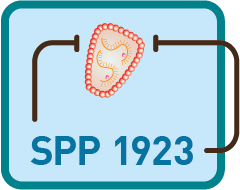Cellular and Viral Determinants of Innate HIV Recognition in Macrophages


Project Member

Prof. Dr. Oliver T. Keppler
Max von Pettenkofer-Institut
Ludwig-Maximilians-Universität München
Pettenkoferstr. 9a
80336 München
Germany

Prof. Dr. Veit Hornung
Gene Center Munich
and Department of Biochemistry
Ludwig-Maximilians-Universität München
Butenandtstr. 1
81377 München
Germany
Project Summary
Besides CD4 T‑cells, macrophages constitute the major target cells for HIV infection. Macrophages comprise a critical in vivo-reservoir and play an important role in shaping the immune response. Little is known about their innate sensing mechanisms to detect HIV and the downstream consequences. Studying monocyte-derived macrophages (MDMs), we observed that HIV elicits antiviral gene expression at a step post-integration. Moreover, depletion of the nucleic acid pattern recognition receptors (PRRs) IFI16 or AIM2 markedly enhanced infection and early HIV gene expression. Notably, expression of interferon-stimulated genes (ISGs) was upregulated in HIV-infected MDMs depleted of IFI16 or AIM2, calling into question a direct role of these PRRs in the initiation of antiviral responses. Employing a novel macrophage trans-differentiation system that is amenable to complex genetic manipulation side-by-side with studies in MDMs, we aim at determining (i) the PRRs that are involved in the recognition of HIV, (ii) the stages of the replication cycle at which engagement occurs, (iii) the viral nucleic acid and protein components that are recognized, and (iv) the functional consequences of this innate pathogen sensing. Collectively, these studies will contribute to our understanding of the mechanisms and functional consequences of HIV recognition by the innate immune system in macrophages.
Fig. 1: Model of emerging complexity of HIV recognition in primary human cells. (a) Inefficient HIV‑1 infection of MDDCs and MDMs due to SAMHD1 restriction. (b) Virion-packaged or artificially VLP-delivered Vpx overcome the SAMHD1 restriction in MDDCs and MDMs and allow recognition of HIV‑1 cDNA prior to integration in a CA-CypA-dependent manner via cGAS and/or IFI16 (Gao et al., 2013; Jakobsen et al., 2013; Lahaye et al., 2013). It has been proposed that sensing requires specific mutations in the HIV‑1 CA (Lahaye et al., 2013; Rasaiyaah et al., 2013). © Vpx co-delivery overcomes the MDDC resistance to productive HIV‑1 infection and unmasks a post-integration recognition through a still unknown sensor that may depend on CypA and de novo-synthesis of CA (Manel et al., 2010). (d) IFI16-dependent pyroptosis in resting CD4 T‑cells in tonsil histocultures (Monroe et al., 2014).


